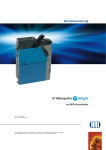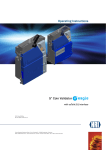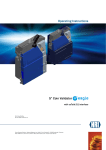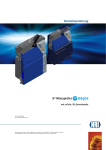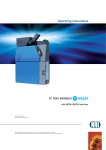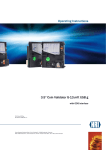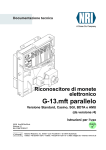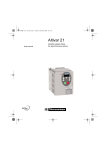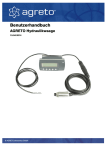Download Operating Instructions 5“ Coin Validator
Transcript
Operating Instructions 5“ Coin Validator with BDTA interface 08.11 Hns/GS/Roe BA_v2_eagle_BDTA_EN_1-1 Crane Payment Solutions GmbH | Zum Fruchthof 6 | 21614 Buxtehude | Germany Web: [email protected] | www.craneps.com | Phone: +49 (0) 41 61-729-0 | Fax: +49 (0) 41 61-729-115 Table of Contents Table of Contents 1 Revision protocol 7 2 About ... 8 2.1 About these operating instructions 2.1.1 Text conventions 2.1.2 Additional useful technical documentation 8 8 9 2.2 About the v2 eagle 2.2.1 The v2-eagle features 2.2.2Models 9 9 10 Safety instructions 11 3.1 Proper use 11 3.2 Protecting persons and equipment 11 2.2.2.1 2.2.2.2 3 Coin entry and return area Internal 5-fold sorting 4Design BA_v2_eagle_BDTA_EN_1-1 10 10 12 4.1Overview 12 4.2 Coin path 13 4.3Label 4.3.1 Model number decoding 4.3.2 Data block decoding 14 15 15 4.4 Switch blocks 4.4.1 Switch functions – switch block S1 4.4.2 Switch functions – switch block S2 16 16 16 4.5 Coin return lever 17 4.6Interfaces 17 National Rejectors, Inc. GmbH, Buxtehude 3 Table of Contents 5Function 18 5.1 Coin acceptance and coin channels 18 5.2 Memory blocks 19 5.3 Accepted coin sensor and sorting control 19 5.4 Transmission of coin values via coin pulses and coin signal lines20 5.4.1 Multiple pulse 20 5.4.2 Coin pulse length 20 5.5 Coin inhibition/activation of narrow coin channels 21 5.5.1 Inhibiting all coins via the machine control system (common inhibit/blocking) 21 5.5.2 Inhibiting individual coins/coin channels via the machine control system (individual inhibit/blocking) 21 5.5.3 Inhibiting individual coins/coin channels via the switch blocks 21 5.6 Sorting accepted coins (option) 5.6.1 Sorting principle of 5-fold longitudinal sorting (Ex8xP4. ..) 5.6.1.1 Sorting with NRI 4-fold sorting adapter (option) 5.6.2 Activation of a cash-box/spare sorting chute (option) 22 22 23 24 5.7 Teach mode (option) 25 5.8 String recognition (option) 25 6Start-up 26 7Operation 27 7.1 Selecting the memory block ... 27 7.1.1 ... using the switch block on the coin validator 27 7.1.2 ... via machine control (single inhibit signal line 6, option)27 4 7.2 Inhibiting coins/activating narrow coin channel 7.2.1 Inhibit functions – switch block S1 7.2.2 Inhibit functions – switch block S2 28 28 28 7.3 Teaching coin channels in teach mode (optional) 30 National Rejectors, Inc. GmbH, Buxtehude BA_v2_eagle_BDTA_EN_1-1 Table of Contents 8 9 Maintenance and service 32 8.1 Cleaning the coin runway 32 8.2Troubleshooting 33 What subsequent settings can be made? 34 9.1 Service and configuration tools 9.1.1 PC configuration software heartbeat 9.1.2 On-site service tool HENRI+ 34 34 34 9.2 Which device functions can be set? 34 10 Technical data 10.1 Device data 35 10.2 Machine interface 10.2.1Pin assignment 10.2.2Interface description 10.2.3Connection diagram 36 36 37 38 10.3Accessories 10.3.1Front plates 10.3.2Sorting adapter 39 39 39 11Index BA_v2_eagle_BDTA_EN_1-1 35 40 National Rejectors, Inc. GmbH, Buxtehude 5 Revision protocol 1 Revision protocol BA_v2_eagle_BDTA_EN_1-1 Version Revision Chapters/sections concerned _1-1 Figure in example added 7.2 "Inhibiting coins/activating narrow coin channel" 7 About ... 2 About ... 2.1 This chapter is intended to provide a general overview of the advantages and options of the coin validator v2 eagle with parallel BDTA interface. The first section, however, is designed to help you navigate easily within these operating instructions. About these operating instructions These operating instructions describe the design and operation of the electronic 5" coin validator v2 eagle with parallel BDTA interface. Afterwards, chapters 6 and 7 explain the necessary steps for starting up and operating the coin validator. Chapter 7 describes how to clean the coin validator and remedy the cause of any malfunction. Chap. 10 "Technical data" and the appended "Index" reduce the search for specific explanations. 2.1.1 Text conventions To make it easier for you to navigate within these operating instructions and to operate the device, the following accentuations were made in the text: 8 Safety instructions which you must observe in order to protect operators and equipment. Special notes intended to facilitate the use of the coin validator. At the beginning of each chapter you will find a short "guide" which summarizes the contents of the chapter. Device functions which are set or prepared by the manufacturer a c c o r d i n g to c u s to m e r s p e c i f i c a t i o n s a n d c a n b e s e t o r changed using our service and configuration tools (cf. Chap. 9 What subsequent settings can be made?, p. 34). 1 2 3 ... Requests to perform an action are numbered in another typeface. [Fig. 1/2] Reference to a figure. The number preceding the slash indicates the number of the figure, the number following the slash is the number of the item in the figure. BA_v2_eagle_BDTA_EN_1-1 About ... 2.1.2 Additional useful technical documentation Apart from the operating instructions you already have, further documentation is available for the v2 eagle, e.g. documentation concerning configuration. All documentation can be downloaded from the NRI homepage (www.nri.de) as pdf file. 2.2 About the v2 eagle The v2-eagle coin validator with parallel BDTA interface in the standardized 5“ format uses the patented multi-frequency technology (MFT) for reliable coin validation. Communication with the vending machine control system takes place via the 16-pin BDTA connecting plug. Due to its modular, compact design the v2 eagle is ideally suited for slot and vending machines. For coin acceptance the coin validator has 32 coin channels which – divided into 2 x 16 coin channels – can be managed in two memory blocks with different coin configurations and selected individually. Depending on the application the coin validator can optionally be equipped with 5-fold sorting. To be able to react as quickly as possible to new false coins and to make your individual settings, the coin validator can be configured on site in the machine using a service tool or in the workshop via a PC programming station. Any coins or tokens not taken into account by the manufacturer can be programmed in the optional teach mode directly on the coin validator without any configuration software by inserting the coins. 2.2.1 The v2-eagle features • Reliable acceptance of genuine coins and rejection of false coins due to MFT multiple sensing of the coins inserted and evaluation of 24 measuring parameters • Operating and manipulation safety provided by optical accepted coin sensors and sorting control in the coin validation and coin outlet area • Acceptance speed of two coins per second • 32 coin channels managed in two independently configured and individually selectable memory blocks (2 x 16 coin channels) • Service interface for PC programming station or on-site service tool • Flash technology for easy and time-saving firmware updates (CXflash)) • Options –– teach mode for eight coin channels –– string sensor –– top or front entry, front or bottom return –– front plate –– 5-fold longitudinal sorting –– four different return levers depending on machine type BA_v2_eagle_BDTA_EN_1-1 9 About ... 2.2.2 Models The v2 eagle is available in different models. They mainly differ • in the coin insert and return area • in the sorting mechanism. 2.2.2.1 Coin entry and return area • Top entry and bottom return (E1xxP4. ../E2xxP4. ..) The coin is inserted into the device from the top and returned, if not accepted, via the return area at the bottom. • Front entry and bottom return (E3xxP4. ..) The coin is inserted into the device from the side and returned, if not accepted, via the return area at the bottom. The coin validator with front entry generally has an NRI front plate fitted to the left-hand side of the device (cf. Chap. 10.3 Accessories, p. 39). However, this model is also available without front plate. • Front entry and bottom return (E4xxP4. ..) The coin is inserted into the device from the side and returned, if not accepted, via the return area also located on the side. The coin validator with front entry and front return generally has an NRI front plate fitted to the left-hand side of the device (cf. Chap. 10.3 Accessories, p. 39). However, this model is also available without front plate. 2.2.2.2 Internal 5-fold sorting In order to sort the accepted coins into the cash-box or e.g. change tubes or hoppers, the v2 eagle can optionally be equipped with an internal 5-fold sorting system (cf. Chap. 5.6 Sorting accepted coins (option), p. 22): • 5-fold longitudinal sorting (Ex8xP4. ..) • Fixed sorting chute in longitudinal sorting system (without sorting) (Ex1xP4. ../Ex2xP4. ../Ex3xP4. ../Ex4xP4. ../Ex5xP4. ..) 10 BA_v2_eagle_BDTA_EN_1-1 Safety instructions 3 Safety instructions Before starting up the device for the first time, please read these instructions and in particular the safety instructions carefully at least once. This is to ensure that you have understood the contents of this manual and how to operate the coin validator. 3.1 Proper use The electronic 5“ coin validator v2 eagle with parallel BDTA interface is intended for use in slot and vending machines with parallel BDTA interface and is designed to check the coins inserted into the machine for specific properties and to accept (and sort) or reject them. Use the coin validator exclusively for this purpose. Under no circumstances can the manufacturer be held liable for any damage or loss resulting from improper use of the device. The coin validator has been built in accordance with state-of-the-art standards and the recognized safety rules. Nevertheless, this equipment can constitute a source of danger. Please observe therefore the following safety instructions. 3.2 Protecting persons and equipment The coin validator may only be connected by a qualified electrician. Use the coin validator only in accordance with its proper use. Under no circumstances can the manufacturer be held liable for any damage or loss resulting from improper use of the device. The coin validator PCB is fitted with components which may be damaged beyond repair by electrostatic discharges. Please observe the handling instructions for components exposed to the risk of electrostatic discharge. Select the correct voltage for the coin validator (see label). Pay attention to correct equipotential bonding in the vending machine. Never pull the connecting cable of the coin validator from the machine when a voltage is applied. Pull the mains plug of the machine before installing, cleaning or removing the coin validator. Contact NRI if you want to modify the device beyond the scope of the modifications or attachments described here. Keep water and other liquids away from the coin validator. Please dispose of the device correctly at the end of its service life. We reserve the right to make technical modifications to the device which are not covered by these instructions! BA_v2_eagle_BDTA_EN_1-1 11 Design 4 Design This chapter describes • the main parts the v2 eagle consists of, and • all parts required for the operation of the coin validator. 4.1 Overview 1 2 8 3 4 12 11 5 10 1 8 2 3 4 5 6 9 8 e gab k Rüc 7 Fig. 1: Design 1 Coin insert funnel (front entry model, open on the side (cf. Chap. 4.2 2 3 4 5 6 12 Coin path, p. 13) Coin return lever (option) Flight deck Locking lever for sorting cover Closing device for flight deck Coin outlet – cash-box/sorting 7 8 9 10 11 12 Coin outlet – return(cf. Chap. 4.2 Coin path, p. 13) Mounting stud Interface – service/configuration Label Interface – machine (BDTA) Switch blocks BA_v2_eagle_BDTA_EN_1-1 Design 4.2 Coin path Top entry Front entry with bottom return ... Front return Fig. 2: Coin path BA_v2_eagle_BDTA_EN_1-1 13 Design 4.3 Label The label of the coin validator [Fig. 1/10] contains all data defining the device, such as device number and type, operating voltage and customer-specific currency and coin programming: 1 2 3 4 8 0000000001 / 0020 / 0005 12-24V DC |BDTA| 07/11 E181P4.00/0.S E0P40-EU---20000A EUR -,10 / -,20 / -,50 / 1,- / 2,- 7 EUR -,10 / -,20 / -,50 / 1,- / 2,- 6 10 9 CRANE 5 NATIONAL REJECTORS, INC. GMBH +49 (0) 41 61 / 729 - 0 * [email protected] Abb. 3: Label 1 Device type 2 Model number (see next section) 3 Bar code 4 Ordering code (10-digit), order number (4-digit), device serial number (4-digit) 5 Date of manufacture 7 Coin programming – memory block 1 (if DIL switch S1 set to ON) 8 Coin programming – memory block 0 (if DIL switch S1 set to OFF) 9 Data block number(cf. Chap. 4.3.2 Data block decoding, p. 15) 10 Nominal voltage 6 Machine interface 14 BA_v2_eagle_BDTA_EN_1-1 Design 4.3.1 Model number decoding MOdEl NuMbER dECOdiNg E181C0.00/0.EPS 0000000001 / 0020 / 0005 12-24V DC |ccTalk| 10/10 E181C0.00/0.EPS E0C00-EU---22000A EUR -,10 / -,20 / -,50 / 1,- / 2,- EUR -,10 / -,20 / -,50 / 1,- / 2,NATIONAL REJECTORS, INC. GMBH +49 (0) 41 61 / 729 - 0 * [email protected] CRANE EXXXXX.XX/X.XXX Options – diverter interface (currenza d2), Encryption, Hardness sensor, Jam sensor, Narrow coin entry, Opto sensor, P = Write protection, String detection, Water protected, X = Interface for external balance Manufacturing process – internal option code & revision Machine interface – C0 = ccTalk, C1 = ccTalk with USB interface, P4 = BDTA, S1, u0 = USBa Coin return lever – 0 = no lever 1–4 = rf. table, 5 = rf. table, #1, bracketed dimensions, 6 = rf. table, #1, yellow, 7 = rf. table, #1, white Sorting – 1..5 = Longitudinal sorting with fixed sorter chute 1..5, 8 = Longitudinal sorting, 9 = Cross sorting Coin entry/outlet – 1 = Top entry, 2 = Top entry, 4th sorter chute narrowed (BDTA), 3 = Front entry/bottom return, 4 = Front entry & return Options Machine interface Equipment v2 family – Eagle 2 3 33.4(30.7) 4 29.2 17.3 25.6(22.7) 23.8 1.5 1 Front view 30.8 Coin return lever # Top edge of device Actuating angle 47° 36° 36° 20 20 20 9.5 Top view 21° 08/11 Hns/Roe Version 1.3 K.V2E-EN Crane Payment Solutions GmbH • Zum Fruchthof 6 • D-21614 Buxtehude • Tel.: +49 (0) 41 61-729-0 • Fax: +49 (0) 41 61-729-115 • E-mail: [email protected] • www.craneps.com 4.3.2 Data block decoding dATA blOCK NuMbER dECOdiNg 0000000001 / 0020 / 0005 12-24V DC |ccTalk| 10/10 E181C0.00/0.EPS E0C00-EU---22000A EUR -,10 / -,20 / -,50 / 1,- / 2,- E0C00-EuCH-20243A EUR -,10 / -,20 / -,50 / 1,- / 2,- CRANE NATIONAL REJECTORS, INC. GMBH +49 (0) 41 61 / 729 - 0 * [email protected] EXXXX-XXXX-XXXXXX data block revision A–Z 3-digit consecutive number Write protection – 0 = No protection, 1 = ACMI, 2 = VDAI, 9 = dll remote configuration Configuration Memory block/Coin channels – 1 = 1 x 32 coin channels, 2 = 2 x 16 coin channels Second currency – XX = First 2 digits of ISO4217 currency code, -- = no 2nd currency, +2 = 2nd & 3rd currency, +3 = 2nd, 3rd & 4th curr. Main currency – XX = First 2 digits of ISO4217 currency code (EU = Euro, CH = Swiss franc, US = US dollar) Currency Hardware relevant to coin acceptance – 0 = Standard Machine interface – C0 = ccTalk, C1 = ccTalk with USB interface, P4 = BDTA, S1, u0 = USBa Measurement variant – V0, V1 Hardware v family – Eagle 2 BA_v2_eagle_BDTA_EN_1-1 Crane Payment Solutions GmbH • Zum Fruchthof 6 • D-21614 Buxtehude • Tel.: +49 (0) 41 61-729-0 • Fax: +49 (0) 41 61-729-115 • E-mail: [email protected] • www.craneps.com 15 02/11 Hns/Roe Version 1.1 K.V2E-EN Design 4.4 Switch blocks The coin validator has two switch blocks [Fig. 1/12] with ten DIL switches each (S1.1‑10 and S2.1–10) on the rear of the device. The DIL switches can be used to set certain device functions: For details on how to use the switch blocks to set the individual functions, see Chap. 7 Operation, p. 27. 4.4.1 On the rear of the device you will find a brief description of the individual switch functions. Switch functions – switch block S1 DIL switch Function OFF ON S1.1 Coin channel 1 enabled inhibited S1.2 Coin channel 2 enabled inhibited S1.3 Coin channel 3 enabled inhibited S1.4 Coin channel 4 enabled inhibited ON S1.5 Coin channel 5 enabled inhibited OFF S1.6 Coin channel 6 enabled inhibited S1.7 Coin channel 7 enabled inhibited S1.8 Coin channel 8 enabled inhibited S1.9 not used – – Memory block 0 1 S1.10 4.4.2 Switch functions – switch block S2 DIL switch Function OFF ON S2.1 Coin channel 9 enabled inhibited S2.2 Coin channel 10 enabled inhibited S2.3 Coin channel 11 enabled inhibited S2.4 Coin channel 12 enabled inhibited S2.5 Coin channel 13 enabled inhibited S2.6 Coin channel 14 enabled inhibited S2.7 Coin channel 15 enabled inhibited S2.8 Coin channel 16 enabled inhibited S2.9 Operating mode Normal mode Teach mode not used – – S2.10 16 ON OFF BA_v2_eagle_BDTA_EN_1-1 Design 4.5 Coin return lever The return lever [Fig. 1/2] on the top of the device is operated using the return button on the machine when coins which have been inserted are to be returned or e.g. a jam caused by coins which have become stuck needs to be removed. Actuation of the return lever opens the measurement and validation area of the coin validator so that all objects in the coin validator are directed to the return area. The v2 eagle can be equipped with different return levers, depending on the dimensions of the machine (cf. Chap. 4.3.1 Model number decoding, p. 15). 4.6 Interfaces For details of the machine interface [Fig. 1/11] please refer to Chap. 10 Technical data, p. 35. BA_v2_eagle_BDTA_EN_1-1 17 Function 5 Function This chapter describes how the coin validator works: • Coin acceptance and coin channels • Memory blocks • Accepted coin sensor and sorting control • Coin pulses and signal lines • Coin inhibition/activation of narrow coin channels • Sorting accepted coins (option) • Teach mode (option) • String recognition (option) 5.1 Coin acceptance and coin channels For coin acceptance the coin validator has 32 "memory slots" to which up to 32 different coin types or tokens can be assigned. These "memory slots" are called coin channels. The acceptance band of one coin type/token is assigned to each coin channel and the respective coin type/ token is accepted in this channel. To enable reliable rejection of false coins, channels with a narrow or even very narrow acceptance band are frequently set up for a coin type in addition to the normal coin channel. The limit values of these coin channels are closer to one another so that false coins with similar measured values are rejected, if the normal channel is inhibited (cf. Chap. 7.2 Inhibiting coins/activating narrow coin channel, p. 28). Narrow and very narrow coin channels, however, also feature a lower acceptance rate. In addition, it is possible to assign coins with different measured values but identical coin values to different coin channels. In this way the coin validator can accept e.g. old and new coins of the same denomination. In addition to the acceptance band of a coin type, further coin information which defines further processing of the coin after its acceptance is assigned to a coin channel: e.g. the coin signal line and pulse number or sorting information for a sorting device. Since in most cases not all coin channels are assigned by customized factory programming, further coin types and the desired information can be assigned to these free channels at any time using the NRI configuration and service tools. Existing configurations can be changed. Eight coin channels are intended to be used for the teach mode. In these teach channels new tokens/coin types can be taught also without configuration and service tools, directly on the coin validator using the switch blocks. I.e. a new coin or token is assigned to a channel (cf. Chap. 5.7 Teach mode (option), p. 25). 18 BA_v2_eagle_BDTA_EN_1-1 Function 5.2 Memory blocks The v2 eagle manages two separately programmed (memory) blocks 0 and 1 (cf. Chap. 4.3 Label, p. 14). 16 coin channels with different coin types (also currencies), sorting information etc. can be assigned to each block. Only one block at a time can be active and used for coin measurement and further coin processing. You can use the switch block on the device to select the desired block (cf. Chap. 7.1 Selecting the memory block ..., p. 27). 5.3 On request, the respective other memory block can also loaded via the machine. This requires that the coin validator is programmed in the factory in such a way that the single inhibiting line 6 (pin 4) can no longer be used for inhibiting but for block switching. In this case coin line 1 (pin 13) is not only available for transmitting coin pulses, but also for the feedback to block switching (cf. Chap. 7.1 Selecting the memory block ..., p. 27) and (cf. Chap. 10.2 Machine interface, p. 36). Accepted coin sensor and sorting control To ensure that accepted coins actually arrive in the cash-box or sorting device and that acceptance has not been tampered with, an accepted coin sensor (light barrier) and a sorting control (light barrier) check whether the inserted coin drops unhindered through the coin outlet towards the cash-box or sorting device. Only when the coin has passed these checking devices a coin signal or, in case of manipulation, an error code is transmitted to the machine. BA_v2_eagle_BDTA_EN_1-1 19 Function 5.4 Transmission of coin values via coin pulses and coin signal lines By default each coin accepted by the coin validator sends a pulse to the machine control via the coin signal line assigned to it. A pulse signals to the machine control that a coin has been accepted. Six coin signal lines are available to the coin validator. Depending on the signal line activated the machine knows the coin denomination (coin value) concerned. Assignment of coin denomination and coin signal line is determined by customized factory programming. 5.4.1 For distinction you also can assign a certain combination of signal lines, i.e. several signal lines, to a coin denomination. Multiple pulse If the number of coin denominations programmed exceeds the number of signal lines available, several coin pulses (multiple pulses, 255 max.) per coin can be assigned to the coin denominations, so that the machine distinguishes the coin denominations not by the signal line but by the number of pulses. In this case a multiple of a small coin is assigned to higher value coins, e.g. if a 2 Euro coin is inserted two coin pulses would be sent to the vending machine control via the coin signal line assigned to the 1 Euro coin. The number of coin pulses is determined by customized factory programming. By default the pulse-to-pause ratio is programmed 1:1. However, it can also be programmed with a longer pause of 500 ms. 5.4.2 Coin pulse length By default the coin pulse length is programmed to 100 ms. On request, however, it can be programmed shorter, e.g. for multiple pulses (possible programming: 30–300 ms). 20 BA_v2_eagle_BDTA_EN_1-1 Function 5.5 Coin inhibition/activation of narrow coin channels If coins are no longer to be accepted for payment on the machine you can either • inhibit coin acceptance completely, • inhibit all coin channels of a certain coin to ensure that this coin is no longer accepted, or • inhibit the normal coin channel of a certain coin so that this coin is accepted only in the narrow channel. 5.5.1 Inhibiting all coins via the machine control system (common inhibit/ blocking) The machine can inhibit coin acceptance via the common inhibit/blocking signal line. In this case the coin validator does not accept any coins (cf. Chap. 10.2 Machine interface, p. 36). 5.5.2 Inhibiting individual coins/coin channels via the machine control system (individual inhibit/blocking) For inhibiting a coin six single inhibit signal lines are available to the machine to • inhibit all coin channels of a certain coin, e.g. if there is no more change in an external payout unit or in case of high fraud hazard. • inhibit the normal coin channel of a certain coin so that this coin is accepted only in the narrow channel. (cf. Chap. 10.2 Machine interface, p. 36). 5.5.3 The coin type or coin channel and the signal line via which it is to be inhibited are determined by customized factory programming. Inhibiting individual coins/coin channels via the switch blocks As an alternative to inhibition via the control system you can inhibit individual coin channels on site via the switch blocks on the coin validator. Chap. 7.2 Inhibiting coins/activating narrow coin channel, p. 28 describes how to inhibit these coin channels. BA_v2_eagle_BDTA_EN_1-1 21 Function 5.6 Sorting accepted coins (option) To direct accepted coins either to the cash-box or an external sorting device, e.g. change tubes or hoppers, the coin validator can be equipped with a 5-fold longitudinal sorting mechanism at the coin outlet. The chutes are controlled via a flap sorting system using three solenoids. In this section you learn all about the principle of • longitudinal sorting –– without optional sorting adapter –– with optional sorting adapter • activation of a cash-box/spare sorting chute (option) 5.6.1 Sorting principle of 5-fold longitudinal sorting (Ex8xP4. ..) The individual coin types can be distributed to the five chutes arranged behind one another independent of their dimensions. Each chute can be defined as cash-box chute. Which coin is sorted into which of the up to five chutes is determined by customized factory programming. Use the single inhibit signal l i n e s fo r ex te r n a l s o r t i n g control: If the same coin is configured in two different coin channels with identical acceptance bands (in the factory or by heartbeat), you can assign different sorting chutes to the two coin channels. If, in addition, different single inhibit signal lines are assigned to the two channels, the machine can sort the coin via the single inhibit signal lines into either of the two sorting chutes or into both. 1 2 3 4 5 urn Ret Fig. 4: Sorting chute 1–5 of longitudinal sorting system 22 BA_v2_eagle_BDTA_EN_1-1 Function 5.6.1.1 Sorting with NRI 4-fold sorting adapter (option) For the purpose of splitting-up and for better transport of the sorted coins you have the option of an NRI 4-fold sorting adapter (manifold) which can be screwed to the coin validator from the bottom. This adapter is primarily used in AWP and SWP slot machines. If the sorting adapter is installed four sorting chutes are available to you (cf. Chap. 10.3 Accessories, p. 39). Which coin is sorted into which of the up to four chutes is determined by customized factory programming. The following table shows which adapter (manifold) chute corresponds to which coin validator chute: Manifold chute v2-eagle sorting chute A 3 B 2 C 1 D 5 urn Ret Fig. 5: Sorting chute A–D of sorting adapter BA_v2_eagle_BDTA_EN_1-1 23 Function 5.6.2 Activation of a cash-box/spare sorting chute (option) If the machine control shall sort coins into the cash-box chute or into a spare sorting chute when the external sorting device sends a "full" signal, the coin validator can be programmed in the factory in such a way that, depending on the status of the single inhibit signal line 6 (pin 4) (high/low), the single inhibit signal lines 1‑5 either • inhibit coins by default (single inhibit signal line 6 = low, single inhibit lines 1‑5 = high) or • sort the coins assigned to the single inhibit signal lines into the cash-box (single inhibit signal line 6 = high, single inhibit signal lines 1‑5 = high) (cf. Chap. 10.2 Machine interface, p. 36). Cash-box/spare sorting chute The machine alternatively sends inhibit and sort signals to the coin validator via the single inhibit signal lines if no coin is accepted. The information is stored by the coin validator whenever the signal is present for at least 10 ms. 24 If the cash-box chute is controlled via the single inhibit signal line 6, only five instead of six signal lines are available for coin acceptance and inhibiting. BA_v2_eagle_BDTA_EN_1-1 Function 5.7 Teach mode (option) If the v2 eagle has been programmed accordingly in the factory, coin channels can be taught in the teach mode without configuration software via the switch block on the coin validator, i. e. a new token or coin is assigned to a coin channel. The new acceptance band is generated by inserting the tokens/coins. It is not necessary to remove the coin validator from the machine for this purpose. The last eight coin channels 9–16 (= teach channels) of the activated memory block are available for teaching (cf. Chap. 7.3 Teaching coin channels in teach mode (optional), p. 30). 5.8 String recognition (option) To ensure that no coins suspended from a string can be inserted into the coin validator or that the acceptance gate cannot otherwise be tampered with, the coin validator can be equipped with an optical string sensor (cannot be retrofitted) in the acceptance area which recognizes both tight and loose strings. The construction of the acceptance gate (dismounted in figure) makes the string go through the light beam between the two optical sensors. If the acceptance gate is completely closed, the string changes the light signal. If the acceptance gate is slightly open (tight string), the light beam is directly interrupted by flag on the acceptance gate. If the sensor recognizes a string, coin signal line 1 or 6 sends a string signal to the machine and the coin is not accepted. At first, coin acceptance is inhibited for 30 seconds. If the string is not removed within this time period and the sensor continues to recognize it, coin acceptance remains inhibited and in addition all "jammed coins" are automatically released. Fig. 6: Section – string recognition Whether the string signal is sent via coin signal line 1 or 6 is determined by customized factory programming (cf. Chap. 10.2 Machine interface, p. 36). Sensitivity of the string sensor BA_v2_eagle_BDTA_EN_1-1 To enable faster testing of the string sensor for functioning, coin acceptance is not inhibited when diagnosis is performed. When the string sensor is activated only a string signal is transmitted. If your coin validator works in the G 18 mode - for controlling e.g. an external sorting device via a coin signal - manipulation protection is impaired, because this requires a coin signal at the end of the cash signal. 25 Start-up 6 Start-up For all assembly and installation work on the coin validator and the machine please observe the following safety instructions: • The coin validator may only be connected by a qualified electrician. • The coin validator is not suited for outdoor use. • Do not use the coin validator if the device or connecting cable are damaged. • Select the correct voltage for the coin validator (see label). • Pay attention to correct equipotential bonding in the vending machine. • Never pull the connecting cable of the coin validator from the machine when a voltage is applied. • Pull the mains plug of the machine before installing or removing the coin validator. To install the v2 eagle in a machine with parallel BDTA interface: 1 If necessary make individual settings via the switch blocks [Fig. 7/1] (cf. Chap. 7 Operation, p. 27). 2 Disconnect the machine from the mains supply. 3 Connect the coin validator to the machine using the 16-pin BDTA interface [Fig. 7/2] and the corresponding connecting cable. 4 Hang up the coin validator in the machine using the lateral mounting studs [Fig. 7/3]. 5 Reconnect the mains supply to the machine. 3 1 2 1 Switch block 2 Interface – machine (BDTA) 3 Fig. 7: Installation 26 3 Mounting stud BA_v2_eagle_BDTA_EN_1-1 Operation 7 Operation This chapter describes how to operate the coin validator, i. e. set certain functions on the coin validator: • selecting memory block • Inhibiting coins/activating narrow coin channel • Teaching coin channels in teach mode (option) The settings which are made directly on the coin validator are described. A separate instruction manual describes how to make settings using the PC configuration software heartbeat (cf. Chap. 9 What subsequent settings can be made?, p. 34). Chap. 5 Function, p. 18 7.1 describes the functions of the adjustable device options. Selecting the memory block ... If the coin validator is to access the other memory block and e.g. accept Euro coins instead of the national currency coins, the desired memory block can be selected via the upper switch block on the coin validator or from the machine via a signal line: 7.1.1 ... using the switch block on the coin validator 1 Unhook the coin validator from the machine. 2 For memory block 1 set DIL switch S1 to ON (up), for memory block 0 set DIL switch to OFF (down). Memory block 0 selected Memory block 1 selected 3 Remount coin validator in the machine. 4 Switch power off and on again. The required memory block is activated. 5 Check coin acceptance of the new memory block selected. 7.1.2 ... via machine control (single inhibit signal line 6, option) If the coin validator has been programmed accordingly in the factory, the other memory block in each case can also be loaded via the machine: 1 For memory block 1 set single inhibit signal line 6 (pin 4) to High, for memory block 0 to Low. The coin validator responds via coin signal line 1 (pin 13): • 10 ms pulse = memory block 0 • 20 ms pulse = memory block 1 • 30 ms pulse = error 2 Check coin acceptance of the new memory block selected. BA_v2_eagle_BDTA_EN_1-1 27 Operation 7.2 Inhibiting coins/activating narrow coin channel Using the two switch blocks on the coin validator you can inhibit on site each of the 16 coin channels of the activated memory block or each coin assigned to certain coin channels, which means that the inhibited channels are not used for payment on the machine: • Accept coin unrestrictedly: all channels assigned are enabled • Narrow the acceptance band of a coin: inhibit normal channel • Inhibit coin: inhibit all channels assigned The 16 DIL switches inhibit the following coin channels: 7.2.1 Inhibit functions – switch block S1 DIL switch Function OFF ON S1.1 Coin channel 1 enabled inhibited S1.2 Coin channel 2 enabled inhibited S1.3 Coin channel 3 enabled inhibited S1.4 Coin channel 4 enabled inhibited S1.5 Coin channel 5 enabled inhibited S1.6 Coin channel 6 enabled inhibited S1.7 Coin channel 7 enabled inhibited S1.8 Coin channel 8 enabled inhibited 7.2.2 Inhibit functions – switch block S2 DIL switch Function OFF ON S2.1 Coin channel 9 enabled inhibited S2.2 Coin channel 10 enabled inhibited S2.3 Coin channel 11 enabled inhibited S2.4 Coin channel 12 enabled inhibited S2.5 Coin channel 13 enabled inhibited S2.6 Coin channel 14 enabled inhibited S2.7 Coin channel 15 enabled inhibited S2.8 Coin channel 16 enabled inhibited On the rear of the device you will find a brief description of the individual switch functions with the factory assignment of coin denomination and coin channel. This assignment can have been changed by means of the configuration software. If all coins are to be accepted for payment on the machine without restriction, the DIL switches S1.1–S1.8 and S2.1–S2.8 of the two switch blocks are set to OFF (down). If you want to inhibit any coin channel, you only must set the corresponding DIL switch to ON (up). 28 BA_v2_eagle_BDTA_EN_1-1 Operation Example The coin validator shall not use coin channels 3 and 10 for coin acceptance, so that coin channels 3 and 10 must be inhibited With this setting the coin channels 3 and 10 are not used! If a normal and a narrow coin channel are programmed on the coin validator for one coin denomination, the normal coin channel must be inhibited as described above to enable activation of the narrow coin channel. If both channels are enabled, the broader acceptance band of the normal coin channel is used. If the coin denomination is to be inhibited, both coin channels must be inhibited. To inhibit coin channels on the coin validator: 1 Unhook the coin validator from the machine. 2 Inhibit the desired coin channels via DIL switches S1.1–8 and S2.1–8 (cf. example above). The desired coin channels have been inhibited. 3 Remount coin validator in the machine. BA_v2_eagle_BDTA_EN_1-1 29 Operation 7.3 Teaching coin channels in teach mode (optional) If the v2 eagle has been programmed accordingly in the factory, up to eight coin channels (teach channels) can be taught on the coin validator via the bottom switch block in order to create new acceptance bands. You need at least ten coins/tokens of the new type. In the teach mode the following switches have the following functions: DIL switch Function OFF ON S2.1 Teach mode – Teach channel 9 S2.2 Teach mode – Teach channel 10 S2.3 Teach mode – Teach channel 11 S2.4 Teach mode – Teach channel 12 S2.5 Teach mode – Teach channel 13 S2.6 Teach mode – Teach channel 14 S2.7 Teach mode – Teach channel 15 S2.8 Teach mode – Teach channel 16 S2.9 Teach mode OFF ON Proceed as follows to assign a new coin/token to coin channel 9-16 of the active memory block: Please note the current switch position to be able to reset the switch to this position for normal operation. 1 Unhook the coin validator from the machine. 2 Set DIL switches S2.1–9 to OFF (down). 3 Set DIL switch S2.9 to ON (up). The device is in the teach mode for teaching the coin channels. 4 Select the coin channel to be taught (9–16, here: 11) by setting the corresponding DIL switch (S2.1–8, here: S2.3) to ON (up). S2 S2 S2 5 Insert at least 10 coins of the new coin type/token into the coin validator or machine. After the 10th coin has been inserted, the acceptance gate is operated once (brief clacking sound). Further coins can be inserted. If there is no signal after the 10th coin has been inserted, the coins inserted cannot be used. Now you can save the measured values generated by the inserted coins with a normal (a) or a wide (b) acceptance band. A wide acceptance band is an appropriate choice when you only have a limited selection of coins at your disposal for the purpose of teaching tokens. 30 BA_v2_eagle_BDTA_EN_1-1 Operation To save with the normal acceptance band: 6a Reset DIL switch S2.9 to OFF (down). Successful saving is signalled by the acceptance S2 gate attracting once. A saving error is signalled by the acceptance gate attracting twice (brief cracking sounds), if e.g. the acceptance band of the coins inserted and the acceptance band of a coin channel already programmed overlap, or the measured values generated are too different and the tolerances would become too large. To cancel the process first set the DIL switch of the respective coin channel (S2.1–8, here: S23) and then DIL switch S2 9 to OFF (down). To save with the wide acceptance band: 6b S e t a n a d d i t i o n a l D I L s w i t c h S 2 . 1 – 8 (here: S2.1) to ON (up). The acceptance band has been widened. S2 Now you can reset DIL switch S2.9 to OFF (down). S2 Successful saving is signalled by the acceptance gate attracting once. A saving error is signalled by the acceptance gate attracting twice (brief cracking sounds), if e.g. the acceptance band of the coins inserted and the acceptance band of a coin channel already programmed overlap, or the measured values generated are too different and the tolerances would become too large. To cancel the process first set the DIL switch of the respective coin channel (S2.1–8, here: S2.3) and the additional DIL switches for the wide acceptance band (here: S2.1) and then DIL switch S2.9 to OFF (down). 7 Reset DIL switch S2.1–8 to the position for normal operation. 8 Remount the coin validator in the machine. 9 Switch power off and on again. The coin validator will now accept the new coin/token for payment. BA_v2_eagle_BDTA_EN_1-1 31 Maintenance and service 8 Maintenance and service This chapter describes how to • clean the v2 eagle and • remedy the cause of malfunctions. 8.1 Cleaning the coin runway On their way through the coin validator the coins may leave residues on sensitive parts which must be removed from time to time to ensure reliable coin acceptance and rejection. Apart from this, no further maintenance work is required. • Cleaning interval: as required, minimum once per year, • Cleaning agent/tool: compressed air/small brush/moistened cloth, lukewarm water Moisten the cloth only slightly to prevent fluid from entering the device. This would damage the PCB. Do not use any solvents or scouring agents which attack the plastic material of the device. 1 Pull the mains plug of the machine. 2 Pull the coin insert funnel [Fig. 8/1] at the front and open the flight deck widely - beyond the first stop. 3 Clean the coin runway in the coin validator using compressed air/brush or a cloth. 4 Remove dust and coin residues from the validation area using cloth/brush or compressed air. 5 Wipe the two sides of the coin runway clean using a slightly moistened cloth. 6 Allow all parts to dry. 7 Close flight deck and press closing device [Fig. 8/2] so that the flight deck audibly clicks into place. 8 Reconnect the machine to the mains supply. 1 2 Fig. 8: Opening and closing the flight deck of the coin validator 32 BA_v2_eagle_BDTA_EN_1-1 Maintenance and service 8.2 Troubleshooting Malfunctions can occur in all electronic devices. These do not always have to be faults in the device.. In many cases improper connections or incorrect settings are the reason. Therefore: please check first of all whether the malfunction can simply be remedied using the following table. Problem Possible cause Coin validator does not accept coin No power supply Return lever pressed/got stuck Coin runway dirty Flight deck not locked Coin inhibited Remedy, hints • Connect cable to validator and machine correctly • Supply machine with voltage Ensure that return lever is not permanently pressed by error Open flight deck and clean coin runway (cf. Chap. 8.1 Cleaning the coin runway, p. 32) Make sure that the flight deck is locked properly by pressing the closing device (cf. Chap. 8.1 Cleaning the coin runway, p. 32) • Make sure that the machine control does not inhibit coin acceptance via common or single inhibit signal lines or the wrong single inhibit signal line has been assigned (cf. Chap. 10.2 Machine interface, p. 36), if necessary, correct using heartbeat • Make sure that the coin is not inhibited via DIL switch on the rear of the device, or that not only the narrow coin channel is enabled and the normal one is inhibited (cf. Chap. 7.2 Inhibiting coins/activating narrow coin channel, p. 28) Coin validator accepts coin, but no credit is given Coin does not exit the device Make sure that the coin outlet is not blocked by foreign objects or devices connected to the bottom of the coin validator If the malfunction cannot be remedied please contact our service technicians. BA_v2_eagle_BDTA_EN_1-1 33 What subsequent settings can be made? 9 What subsequent settings can be made? 9.1 This chapter provides general information concerning the NRI service and configuration tools for the v2 eagle and the device functions which can be configured subsequently. Service and configuration tools Depending on whether you want to configure the coin validator in the workshop or on site a PC software or a mobile service tool is recommended. 9.1.1 PC configuration software heartbeat The PC software heartbeat serves for diagnostics and individual configuration of the new NRI coin validator generation and for updating the complete coin and device configuration using data blocks currently provided by NRI (data block upload). The heartbeat software identifies the coin validator connected to the PC and its device-specific data and displays the data on the screen of your PC for diagnostics and configuration. The separate software manual describes how to connect the coin validator to your PC and how to install and use the software. 9.1.2 On-site service tool HENRI+ For on-site configuration the HENRI+ Service Tool is a suitable tool by which you can update the complete coin and device configuration quickly and reliably via data block upload. The separate short reference guide describes how to connect and use the tool. HENRI+ is also suitable for on-site firmware updates. 9.2 Which device functions can be set? • Acceptance of genuine coins and rejection of false coins (acceptance band adjustment after insertion of genuine coins and false coins) • Coin via channel assignment of –– coin signal line(s) –– Coin pulse number • Sorting via channel assignment of –– sorting chute –– cash-box tube/spare sorting tube (option) • Coin blocking via channel assignment of single inhibit signal line • Sensitivity of the string sensor • New coins/tokens (generation of a new acceptance band and assignment of the coin/sorting data) • Data block upload for current coin and device data 34 BA_v2_eagle_BDTA_EN_1-1 Technical data 10 Technical data This chapter contains • all relevant v2-eagle data • details concerning the machine interface • information concerning v2-eagle accessories 10.1 Device data Supply voltage 10 V to 28 V DC Current consumption max. when accepting coins Acceptance solenoid:approx. 3 W Sorting solenoid: approx. 2 W (max. 2 at the same time) Unom = 12 V Without sorting: approx. 400 mA (for approx. 150 ms) With sorting: approx. 400 mA (for approx. 150 ms) Unom = 24 V Without sorting: approx. 400 mA (for approx. 150 ms) With sorting: approx. 400 mA (for approx. 150 ms) Dielectric strength, in/outputs 28 V max. Current load, outputs 10 mA max. (open collector) Temperature range 0 °C to 60 °C Temperature change 0.2 °C/min. max. Rel. humidity up to 93 % Condensation not permitted Machine interface 6 coin signal outputs (open collector) (active low ≤ 0.8 V) 6 single inhibit signal outputs (open collector) (active high ≥ 3.7 V (acceptance ≤ 0.9 V)) Common inhibit signal input (open collector) (active low ≤ 0.9 V (acceptance ≥ 3.7 V)) Return output (active low ≤ 0.8 V at I = 20 mA) For pin assignment refer to Chap. 10.2 Machine interface, p. 36 Coin acceptance 32 coin types max. in 2 x 16 channels Coin diameter: 15–31 mm (optionally up to 32 mm, at 2.4 mm thickness max.) Coin thickness: 1.5–2.4 mm (optionally up to 3.4 mm) Speed: 2 coins/sec Device dimensions Height:181.3 mm Width: 127.0 mm Depth: 64.0 mm Mounting position vertical, max. deviation: ± 2° Directives applied EMC:2004/108/EC BA_v2_eagle_BDTA_EN_1-1 (+ 2 x 4.5 mm for mounting studs) EN 55 014-2 (interference resistance) EN 55 022 (interference emission) Machinery:2006/42/EC R&TTE: 1999/5/EC (Radio and telecommunications terminal equipment) (cf. Declaration of Conformity) 35 Technical data 10.2 Machine interface On the following pages you will find pin assignment, interface description and the connection diagram for the connection of the v2 eagle to the machine. 10.2.1 Pin assignment The Bundesverband der Deutschen Tabakwaren-Großhändler und Automatenaufsteller (BDTA) (association of German tobacco wholesalers) determined the DTG standard 2 for the electrical interface to the vending machine. This standard includes the specification of the supply voltage, the coin signal lines, inhibit functions and the return signal. In addition to further standardization requirements for validators the measurement quality of validators is also specified. Pin Input/output Function Level 1 IN Single inhibit line 4 active high 2 IN Single inhibit line 5 active high 3 IN Single inhibit line 2 active high 4 IN • Single inhibit line 6 • Memory block 1 selection line (memory block 2 (active low)) active high • Control line for cash-box/spare sorting chute 5 OUT Return line active low 6 IN Common inhibit line active low 7 OUT Coin line 4 active low 8 – Supply 0 V GND • Coin line 6 9 OUT 10 OUT Coin line 2 active low 11 OUT Coin line 5 active low 12 OUT Coin line 3 active low 13 OUT • String line 1 2 active low 15 16 • Coin line 1 • String line active low • Message line for memory block 14 IN Single inhibit line 3 active high 15 IN Single inhibit line 1 active high 16 – Operating voltage UB = +10–28 V DC - 36 All signals must be debounced from the input side. BA_v2_eagle_BDTA_EN_1-1 Technical data 10.2.2 Interface description Coin lines Coin validator signals the coin accepted in the respective coin channel (usually by one pulse, if there are not sufficient lines by multiple pulses) Return line After pressing of the return lever/return button the coin validator signal opening of the measuring and validation area Common inhibit line Machine inhibits coin acceptance Single inhibit line Machine inhibits coin acceptance in the coin channel assigned to the respective line String line (option) Coin validator signals a coin suspended from a string (whether the signal is received via pin 9 or 13 is determined by customized factory programming) Memory block 1 selection line (option) Machine loads memory block 1. (Memory block 0 = line at Low.) With this line function single inhibit line 6 is not available. Memory block message line (option) Coin validator signals which memory block has been activated via the memory block 1 selection line (10 ms = block 0, 20 ms = block 1) or whether an error occurred during memory block loading (30 ms). With this line function short pulse lengths should be defined for coin signals sent via coin line 1. Control line for cash-box/spare sorting chute (option) Machine signals that single inhibit lines 1–5 are used for cash-box/spare chute sorting. BA_v2_eagle_BDTA_EN_1-1 With this line function single inhibit and coin line 6 is not available. 37 Technical data 10.2.3 38 Connection diagram BA_v2_eagle_BDTA_EN_1-1 Technical data 10.3 Accessories To adapt the v2 eagle to your individual requirements you can acquire the following accessories from NRI: 10.3.1 Front plates Accessories Ordering code Front plate for front entry and bottom return................................................ 12918 Front plate for front entry and front return.................................................... 10897 10.3.2 Sorting adapter Accessories Ordering code 4-fold sorting adapter..................................................................................... 10402 BA_v2_eagle_BDTA_EN_1-1 39 Index 11 Index 4-fold sorting adapter 23 5-fold sorting 10 A Accentuations in the text 8 Acceptance band 18 narrow 18 activate 28 new 25 procedure 30 normal 18 very narrow 18 Acceptance, coins 18, 35 inhibit 21 Acceptance speed 35 Accepted coin sensor 19 Accessories 39 Adapter, sorting 23 ordering code 39 Advantages 9 Angle, mounting position 35 Application, proper 11 B Bar code 14 BDTA interface 12, 35 Block 14, 19 external selection line 37 select 27 Blocking line 37 C Cash-box chute 24 external sorting line 37 Change tubes 22 Change units 22 Channels 18 inhibit 28 narrow 18 activate 28 normal 18 very narrow 18 Chapter summary 8 40 Cleaning 32 Coin inhibit 21 procedure 28 new 25 procedure 30 Coin acceptance 18, 35 inhibit 21 procedure 28 Coin channels 18 inhibit 28 narrow 18 activate 28 normal 18 very narrow 18 Coin diameter 35 Coin flight deck closing device 12 open/clean 32 Coin insert funnel 12 Coin outlet 12 Coin path 13 Coin pulse 20 Coin pulse length 20 Coin runway 13 Coin signal line 20, 37 Coins, teaching 25 procedure 30 Coin thickness 35 Coin tubes 22 Coin value 20 Common inhibit/blocking 21 Common inhibit line 37 Condensation 35 Configuration 8, 27, 34 on site (HENRI+) 34 PC programming station (heartbeat) 34 Connections description 36 pin assignment 36 service/configuration 12 vending machine 12 Current consumption 35 Current load, outputs 35 BA_v2_eagle_BDTA_EN_1-1 Index D H Data block number 14 decoding 15 Data block upload 34 Date of manufacture 14 Date of production 14 Design 12 Deviation, mounting position 35 Device, connecting 26 Device dimensions 35 Device number 14 Device type 14 Diagnostics 34 Dielectric strength, in/outputs 35 DIL switch 12, 16 inhibiting coin channel/activating narrow coin channel 28 selecting memory block 27 teaching coins 30 Dimensions 35 Documentation, additional 9 Heartbeat 34 adjustable functions 8, 34 manual 9 HENRI+ 34 Homepage, NRI 9 Hopper 22 Humidity 35 E Electrostatic discharge 11 Employment, proper 11 External sorting 24 F Firmware update 34 Flap sorting system 22 Flight deck closing device 12 open/clean 32 Front entry and bottom return 10 front return 10 Front plate, ordering codes 39 Function 18 G General information chapter 8 coin validator 9 instructions 8 Guide, chapter contents 8 BA_v2_eagle_BDTA_EN_1-1 I Individual inhibit/blocking via switch blocks 28 via vending machine 21 Inhibit, coins 21 procedure 28 Insert funnel 12 Insertion 10 Instructions 8 Instructions, additional 9 Interface label 14 service/configuration 12 vending machine 12, 35, 36 Internet address, NRI 9 Introduction chapter 8 coin validator 9 instructions 8 L Label 14 Lines 20, 37 Longitudinal sorting 22 4-fold sorting adapter 23 M Malfunction, what to do? 33 Manifold 23 ordering code 39 Manuals, additional 9 Marks in the text 8 Measured values 18 Measures 35 Memory block 14, 19 external selection line 37 select 27 41 Index Model number 14 Models 10 decoding of model no. 15 Mounting position 35 Mounting stud 12 Multiple pulse 20 pulse-to-pause ratio 20 N New coin 25 teach 30 Nominal voltage 14 O Open, coin validator 32 Operating instructions, additional 9 Operating voltage 35 Operation 27 Options 10, 39 Ordering code accessories 39 coin validator 14 Order number 14 P Payout units 22 PC programming station (heartbeat) 34 service interface 12 Pictographs in the text 8 Pin assignment 36 Plug service/configuration 12 vending machine 12, 35 Power consumption 35 Power supply 35 Programming 8, 34 on site (HENRI+) 34 PC programming station (heartbeat) 34 Proper use 11 Pulse 20 Pulse length 20 Pulse-to-pause ratio (multiple pulses) 20 42 R Relative humidity 35 Requests to perform an action 8 Return 10, 12 at the bottom and front entry 10 at the bottom and top entry 10 Return lever 12 description 17 Return line 37 S Safety instructions 8, 11 Serial number 14 Settings 8, 27, 34 on site (HENRI+) 34 PC programming station (heartbeat) 34 Signal lines 20, 37 Single inhibit line 37 Software for configuration 34 update 34 Sorting 10, 22 4-fold sorting adapter 23 external 24 figure 22 longitudinal sorting 22 Sorting adapter 23 ordering code 39 Sorting chute 12 Sorting control 19 Sorting line 37 Spare sorting chute 24 Start-up 26 String recognition 25 String signal line 37 Summary, chapter 8 Supply voltage 35 Switch blocks 12 description 16 inhibiting coin channel/activating narrow coin channel 28 selecting memory block 27 teaching coins 30 Symbols in the text 8 BA_v2_eagle_BDTA_EN_1-1 Index T Teach mode 25 procedure 30 Technical data 35 Temperature change 35 Temperature range 35 Tilt, mounting position 35 Top entry and bottom return 10 Troubleshooting 33 Tubes 22 U Update, firmware 34 Use, proper 11 V Variants 10 decoding of model no. 15 W Web site, NRI 9 www.nri.de 9 BA_v2_eagle_BDTA_EN_1-1 43











































